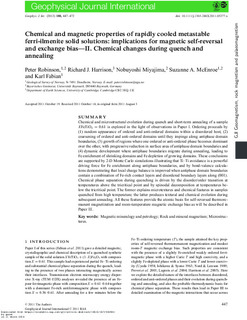| dc.contributor.author | Robinson, Peter | |
| dc.contributor.author | Harrison, Richard J. | |
| dc.contributor.author | Miyajima, Nobuyoshi | |
| dc.contributor.author | McEnroe, Suzanne | |
| dc.contributor.author | Fabian, Karl | |
| dc.date.accessioned | 2018-03-23T10:28:52Z | |
| dc.date.available | 2018-03-23T10:28:52Z | |
| dc.date.created | 2013-06-18T14:47:14Z | |
| dc.date.issued | 2012 | |
| dc.identifier.citation | Geophysical Journal International. 2012, 188 (2), 447-472. | nb_NO |
| dc.identifier.issn | 0956-540X | |
| dc.identifier.uri | http://hdl.handle.net/11250/2491876 | |
| dc.description.abstract | Chemical and microstructural evolution during quench and short-term annealing of a sample XFeTiO3= 0.61 is explored in the light of observations in Paper I. Ordering proceeds by (1) random appearance of ordered and anti-ordered domains within a disordered host, (2) coarsening of ordered and anti-ordered domains until they impinge along antiphase domain boundaries, (3) growth of regions where one ordered or anti-ordered phase becomes dominant over the other, with progressive reduction in surface area of antiphase domain boundaries and (4) dynamic development where antiphase boundaries migrate during annealing, leading to Fe enrichment of shrinking domains and Fe depletion of growing domains. These conclusions are supported by 2-D Monte Carlo simulations illustrating that Ti-Ti avoidance is a powerful driving force for Fe enrichment along antiphase boundaries, and by bond-valence calculations demonstrating that local charge balance is improved when antiphase domain boundaries contain a combination of Fe-rich contact layers and disordered boundary layers along (001). Chemical phase separation during quenching is driven by the disorder/order transition at temperatures above the tricritical point and by spinodal decomposition at temperatures below the tricritical point. The former explains microtextures and chemical features in samples quenched from high temperature; the latter produces textural and chemical evolution during subsequent annealing. All these features provide the atomic basis for self-reversed thermoremanent magnetization and room-temperature magnetic exchange bias as will be described in Paper III. | nb_NO |
| dc.language.iso | eng | nb_NO |
| dc.publisher | Oxford University Press | nb_NO |
| dc.title | Chemical and magnetic properties of rapidly cooled metastable ferri-ilmenite solid solutions: II. Chemical changes during quenching and annealing | nb_NO |
| dc.type | Journal article | nb_NO |
| dc.type | Peer reviewed | nb_NO |
| dc.description.version | publishedVersion | nb_NO |
| dc.source.pagenumber | 447-472 | nb_NO |
| dc.source.volume | 188 | nb_NO |
| dc.source.journal | Geophysical Journal International | nb_NO |
| dc.source.issue | 2 | nb_NO |
| dc.identifier.doi | 10.1111/j.1365-246X.2011.05277.x | |
| dc.identifier.cristin | 1035069 | |
| dc.description.localcode | © 2012 The Authors. Geophysical Journal International © 2012 RAS.Published by Oxford University Press on behalf of the Royal Astronomical Society. All rights reserved | nb_NO |
| cristin.unitcode | 194,64,90,0 | |
| cristin.unitname | Institutt for geovitenskap og petroleum | |
| cristin.ispublished | true | |
| cristin.fulltext | original | |
| cristin.qualitycode | 2 | |
